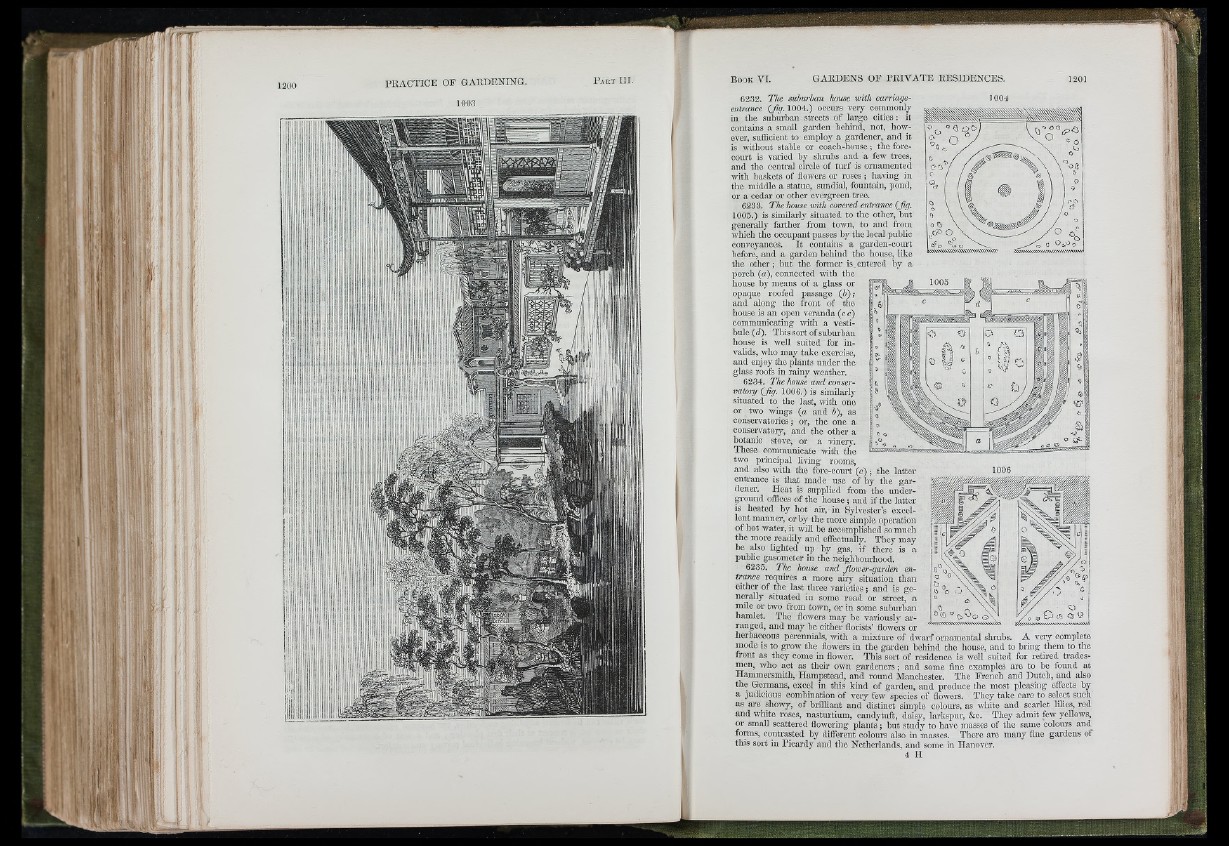
1003 1004
»» 'fl
P ; l ¥
6232. The suburban house with carriage-
entrunce (fig. 1004.) occurs veiy commonly
in the suburban streets of large cities: it
contains a small garden behind, not, however,
sufficient to employ a gardener, and it
is without stable or coach-house; the forecourt
is varied by shinhs and a few trees,
and the central circle of turf is ornamented
with baskets of flowers or roses; having in
the middle a statue, sundial, fountain, pond,
or a cedar or other evergreen tree.
6233. The house with covered entrance (fig.
1005.) is similarly situated to the otlicr, but
generally fai-ther from town, to and from
which the occupant passes by the local public
conveyances. It contains a gardcn-court
before, and a gai'den behind the house, like
the other; but the former is. entered hy a
porch (a), connected with the
house by means of a glass or
opaque roofed passage (¿*);
and along the front of the
house is an open veranda (c c)
communicating with a vestibule
(i/). This sort of suburban
house is well suited for invalids,
who may take exercise,
and enjoy the plants under the
glass roofs in rainy weather.
6234. The house and conservatory
(fig. 1006.) is similarly
situated to the last, with one
or two wings (a ancl b), as
consen'atories; or, the one a
conseiwatoiy, and the other a
botanic stove, or a vinery.
These communicate with the
two principal living rooms,
and also with the forc-couit (c) ; the latter
entrance is that made use of hy the gardener.
Heat is supplied from the under-
^'ound offices of the house; and if the latter
is heated by hot air, in Sylvester’s excellent
manner, or by the more simple operation
of hot water, it will be accomplished so much
the more readily and effectually. They may
be also lighted up by gas, if there is a
public gasometer in the neighbourhood.
6235. The house and fiower-garden entrance
requires a more aiiy situation than
either of the last three varieties; and is generally
situated in some road or street, a
mile or two from town, or in some suburban
hamlet. The flowers may be variously arranged,
and may be cither florists’ flowers or
herbaceous perennials, with a mixture of dwarf ornamental shmbs. A very complete
mode is to grow the flowers in the gai'den behind the house, and to bring them to the
front as they come in flower. This sort of residence is well suited for retired tradesmen,
who act as thcir own gardeners; and somc fine examples are to be found at
Hammersmith, Hampstead, and round Manchester. The French and Dutch, and also
the Germans, excel in this kind of garden, and produce the most pleasing effects hy
a judicious combination of very few species of flowers. They take cai'e to select such
as are shoavy, of brilliant and distinct simple colours, as white and scarlet lilies, red
and white roses, nasturtium, candytuft, daisy, larkspur, &c. They admit few yellows,
or small scattered flowering plants; but study to liave masses of the same colours and
forms, contrasted by different colours also in masses. There are many fine gardens of
this sort in Picardy and the Netherlands, and some in Hanover.
4 H
1006